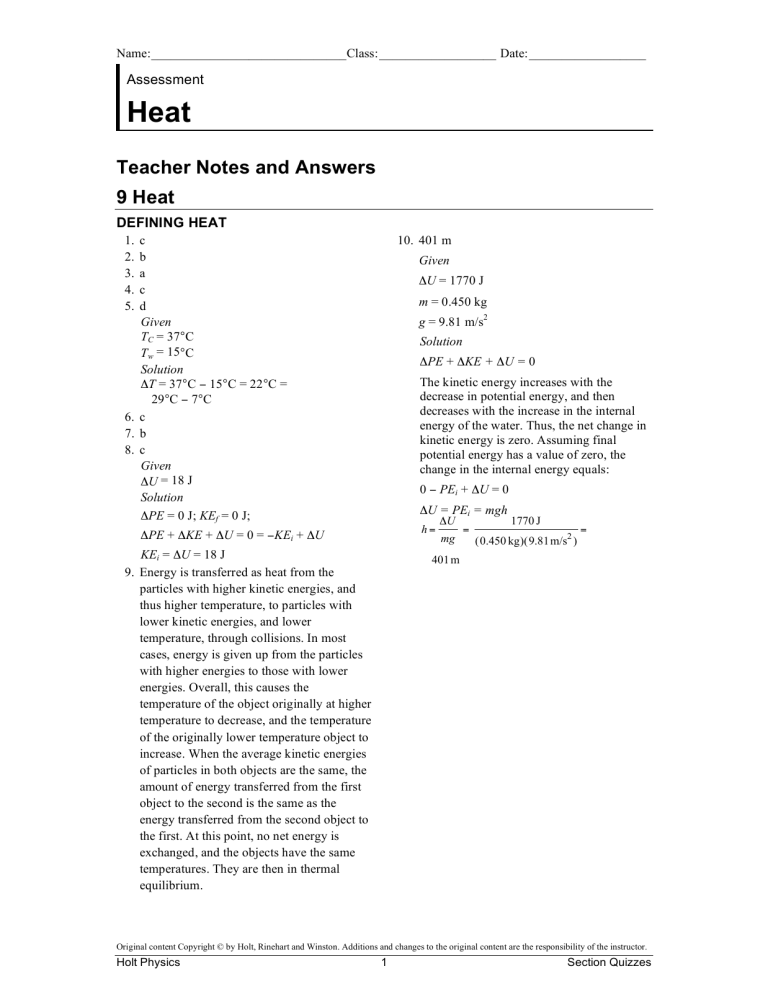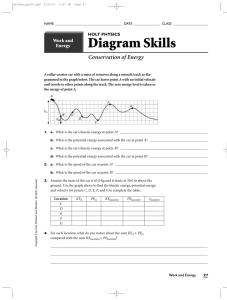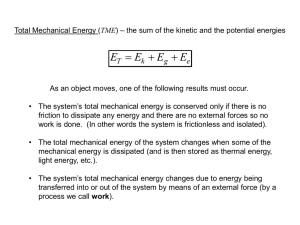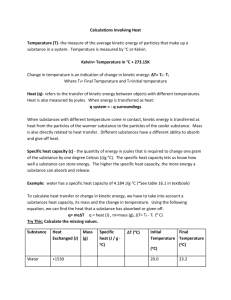
Name:______________________________Class:__________________ Date:__________________ Assessment Heat Teacher Notes and Answers 9 Heat DEFINING HEAT 1. 2. 3. 4. 5. c b a c d Given TC = 37°C Tw = 15°C Solution T = 37°C 15°C = 22°C = 29°C 7°C 6. c 7. b 8. c Given U = 18 J Solution PE = 0 J; KEf = 0 J; 10. 401 m Given U = 1770 J m = 0.450 kg g = 9.81 m/s2 Solution PE + KE + U = 0 The kinetic energy increases with the decrease in potential energy, and then decreases with the increase in the internal energy of the water. Thus, the net change in kinetic energy is zero. Assuming final potential energy has a value of zero, the change in the internal energy equals: 0 PEi + U = 0 U = PEi = mgh h= PE + KE + U = 0 = KEi + U KEi = U = 18 J 9. Energy is transferred as heat from the particles with higher kinetic energies, and thus higher temperature, to particles with lower kinetic energies, and lower temperature, through collisions. In most cases, energy is given up from the particles with higher energies to those with lower energies. Overall, this causes the temperature of the object originally at higher temperature to decrease, and the temperature of the originally lower temperature object to increase. When the average kinetic energies of particles in both objects are the same, the amount of energy transferred from the first object to the second is the same as the energy transferred from the second object to the first. At this point, no net energy is exchanged, and the objects have the same temperatures. They are then in thermal equilibrium. U mg = 1770 J (0.450 kg)(9.81 m/s2 ) = 401 m Original content Copyright © by Holt, Rinehart and Winston. Additions and changes to the original content are the responsibility of the instructor. Holt Physics 1 Section Quizzes Name:______________________________Class:__________________ Date:__________________ Assessment Heat Section Quiz: Defining Heat Write the letter of the correct answer in the space provided. _____ 1. What term is defined as the energy transferred between objects with different temperatures? a. internal energy b. work c. heat d. thermal equilibrium _____ 2. What must be true if energy is to be transferred as heat between two bodies in physical contact? a. The two bodies must have different volumes. b. The two bodies must be at different temperatures. c. The two bodies must have different masses. d. The two bodies must be in thermal equilibrium. _____ 3. What occurs to the particles in a substance at low temperature when energy is transferred to the substance as heat? a. The average kinetic energy of the particles increases. b. The average kinetic energy of the particles remains constant. c. The average kinetic energy of the particles decreases. d. The average kinetic energy of the particles varies unpredictably. _____ 4. If energy is transferred spontaneously as heat from a substance with a temperature of T1 to a substance with a temperature of T2, which of the following statements must be true? a. T1 < T2 b. T1 = T2 c. T1 > T2 d. More information is needed. _____ 5. A container with a temperature of 37°C is submerged in a bucket of water with a temperature of 15°C. An identical container with a temperature of T1 is submerged in an identical bucket of water with a temperature of T2. If the amounts of energy transferred as heat between the containers and the water are the same in both cases, which of the following statements is true? a. T1 = 5°C; T2 = 37°C b. T1 = 10°C; T2 = 47°C c. T1 = 12°C; T2 = 32°C d. T1 = 7°C; T2 = 29°C Original content Copyright © by Holt, Rinehart and Winston. Additions and changes to the original content are the responsibility of the instructor. Holt Physics 1 Section Quizzes Name:______________________________Class:__________________ Date:__________________ Heat continued _____ 6. What is the process by which energy is transferred by the motion of cold and hot matter? a. thermal conduction b. thermal insulation c. convection d. radiation _____ 7. Which of the following is not a good thermal insulator? a. ceramic b. iron c. fiberglass d. cork _____ 8. An arrow strikes a target, causing an internal energy increase of 18 J. If the arrow is fired so that it enters the target at the same height above the ground as when it was fired, what is the arrow's initial kinetic energy? a. 0 J b. 9 J c. 18 J d. 27 J 9. Describe how energy is transferred between two objects at different temperatures, and how they reach thermal equilibrium. _________________________________________________________________ _________________________________________________________________ _________________________________________________________________ _________________________________________________________________ _________________________________________________________________ _________________________________________________________________ 10. A stone with a mass of 0.450 kg is dropped from the edge of a cliff. When the stone strikes the ground, the internal energy of the stone and ground increase by 1770 J. If the stone is initially at rest when it is dropped, how high above the ground is the cliff? (g = 9.81 m/s2) Original content Copyright © by Holt, Rinehart and Winston. Additions and changes to the original content are the responsibility of the instructor. Holt Physics 2 Section Quizzes





